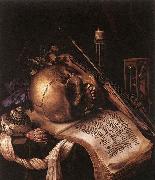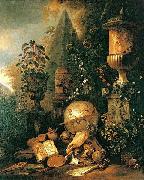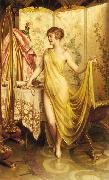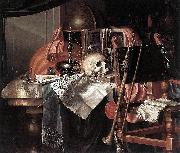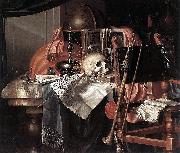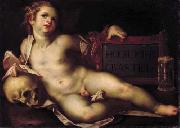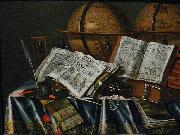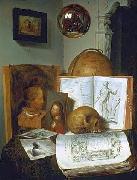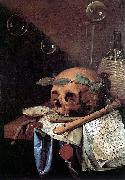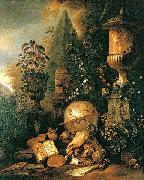Wholesale Oil Painting No Minimum |
|||||||||||
|
|
|||||||||||

|
|||||||||||
|
|
|
||||||||
Renard EmileFrench artist ,1859-1930 |
||||||||
|
|
||||||||
Vanitas
Vanitas Painting ID:: 62372 |
52 x 44 cm Mus?e des Beaux-Arts, Marseille The artist specialized in complex 'Vanitas' pieces of dramatic clarity. The general influence on his art is Netherlandish, and it is likely that his unsigned pictures are still classified under the Northern schools. Most of his pictures are dominated by a grisly skull surrounded by numerous other indications of the brevity of life. He was received into the French Academy in 1663 as a portraitist 52 x 44 cm Mus?e des Beaux-Arts, Marseille The artist specialized in complex 'Vanitas' pieces of dramatic clarity. The general influence on his art is Netherlandish, and it is likely that his unsigned pictures are still classified under the Northern schools. Most of his pictures are dominated by a grisly skull surrounded by numerous other indications of the brevity of life. He was received into the French Academy in 1663 as a portraitist |
|||||||
|
|
||||||||
Frederic Soulacroix19th Century Portrait Painter Victorian Period.1825-1879 |
||||||||
|
|
||||||||
|
|
Vanitas
Vanitas Painting ID:: 70576 |
1858-1933
Oil on canvas
75.6 x 46.4 cm 1858-1933 Oil on canvas 75.6 x 46.4 cm |
||||||
|
|
||||||||
Matthias Withoos(1627-1703), also known as Calzetta Bianca and Calzetti, was a Dutch painter of still lifes and city scenes, best-known for the details of insects, reptiles and undergrowth in the foreground of his pictures. Withoos was born in Amersfoort. He studied under Jacob van Campen, at his painters' school just outside the city at his country house, and then with Otto Marseus van Schrieck. When he was 21, Withoos made a trip to Rome with Van Schrieck, and Willem van Aelst. There they joined the group of northern artists known as the "Bentvueghels" ("Birds of a feather"), and Withoos went by the alias "Calzetta Bianca" ("White Hose") a translation of his name into Italian. Withoos' work caught the eye of the cardinal Leopoldo de Medici, who commissioned various paintings from him. In 1653, the artist returned to Amersfoort.When French troops occupied Amersfoort in the "Disastrous Year" of 1672, Withoos fled from Amersfoort to Hoorn, where he would remain until his death in 1703. |
||||||||
|
|
||||||||
|
|
Vanitas
Vanitas Painting ID:: 71719 |
17th century
Oil on canvas
17th century Oil on canvas |
||||||
|
|
||||||||
Frederic Soulacroix19th Century Portrait Painter Victorian Period.1825-1879 |
||||||||
|
|
||||||||
|
|
Vanitas
Vanitas Painting ID:: 74298 |
Date 1858-1933
Medium Oil on canvas
Dimensions 75.6 x 46.4 cm ?
cyf Date 1858-1933 Medium Oil on canvas Dimensions 75.6 x 46.4 cm ? cyf |
||||||
|
|
||||||||
|
|
||||||||
|
|
Vanitas
Vanitas Painting ID:: 77502 |
Still life
Date
Oil on canvas
115 ?? 134 cm (45.3 ?? 52.8 in)
cjr Still life Date Oil on canvas 115 ?? 134 cm (45.3 ?? 52.8 in) cjr |
||||||
|
|
||||||||
Franciscus Gysbrechts(1672 -1676 ) - Painter |
||||||||
|
|
||||||||
|
|
Vanitas
Vanitas Painting ID:: 80815 |
Medium Oil on canvas
Dimensions 115 x 134 cm (45.3 x 52.8 in)
cyf Medium Oil on canvas Dimensions 115 x 134 cm (45.3 x 52.8 in) cyf |
||||||
|
|
||||||||
Bartholomeus Spranger1546-1611 Flemish Bartholomeus Spranger Gallery Bartholomeus (Bartholomaeus) Spranger (21 March 1546??August 1611) was a Flemish Mannerist painter, draughtsman, and etcher. He was born in Antwerp. In 1565, he traveled to Paris and Italy after finishing his studies. He worked on wall paintings in various churches. At Rome, Pope Pius V appointed him court painter in 1570. In 1581 he was appointed to the Prague court of Rudolf II, Holy Roman Emperor. Hendrik Goltzius made engravings of his paintings, thus increasing Spranger's fame. Spranger's Mannerist paintings depict nudes in various complex poses. He died in Prague. |
||||||||
|
|
||||||||
|
|
Vanitas
Vanitas Painting ID:: 82062 |
after 1600(1600)
Medium Oil on canvas
cyf after 1600(1600) Medium Oil on canvas cyf |
||||||
|
|
||||||||
Bernaert Van OrleyFlemish Northern Renaissance Painter, ca.1488-1541, Painter and tapestry designer, son of Valentin van Orley. He was one of the greatest proponents of ROMANISM, a northern style based on the ideals of the Italian Renaissance. It must have been in Brussels, however, that he saw the Italian works of art that influenced him so profoundly, for it seems unlikely that he ever travelled to Italy. Brussels was then world-renowned as the centre for tapestry manufacture but was suffering from the ecliptic rise of Antwerp as the pre-eminent painting centre. The artist made the best of both situations, establishing himself as a leading designer for the Brussels tapestry industry and as a master in the Antwerp Guild of St Luke by 1517. |
||||||||
|
|
||||||||
|
|
Vanitas
Vanitas Painting ID:: 82774 |
Medium oil on panel
Dimensions 42.5 x 56.6 cm
cyf Medium oil on panel Dimensions 42.5 x 56.6 cm cyf |
||||||
|
|
||||||||
simon luttichuysca 1630-1640 |
||||||||
|
|
||||||||
|
|
Vanitas
Vanitas Painting ID:: 85388 |
Date 17th century
cyf Date 17th century cyf |
||||||
|
|
||||||||
Aved, Jacques-Andre-JosephFrench Painter, 1702-1766 |
||||||||
|
|
||||||||
|
|
Vanitas
Vanitas Painting ID:: 86874 |
1650(1650)
Medium Oil on canvas
cyf 1650(1650) Medium Oil on canvas cyf |
||||||
|
|
||||||||
Matthias Withoos(1627-1703), also known as Calzetta Bianca and Calzetti, was a Dutch painter of still lifes and city scenes, best-known for the details of insects, reptiles and undergrowth in the foreground of his pictures. Withoos was born in Amersfoort. He studied under Jacob van Campen, at his painters' school just outside the city at his country house, and then with Otto Marseus van Schrieck. When he was 21, Withoos made a trip to Rome with Van Schrieck, and Willem van Aelst. There they joined the group of northern artists known as the "Bentvueghels" ("Birds of a feather"), and Withoos went by the alias "Calzetta Bianca" ("White Hose") a translation of his name into Italian. Withoos' work caught the eye of the cardinal Leopoldo de Medici, who commissioned various paintings from him. In 1653, the artist returned to Amersfoort.When French troops occupied Amersfoort in the "Disastrous Year" of 1672, Withoos fled from Amersfoort to Hoorn, where he would remain until his death in 1703. |
||||||||
|
|
||||||||
|
|
Vanitas
Vanitas Painting ID:: 92401 |
Date 17th century
Medium oil on canvas
ttd Date 17th century Medium oil on canvas ttd |
||||||
|
|
||||||||
|
Matthias Withoos (1627-1703), also known as Calzetta Bianca and Calzetti, was a Dutch painter of still lifes and city scenes, best-known for the details of insects, reptiles and undergrowth in the foreground of his pictures. Withoos was born in Amersfoort. He studied under Jacob van Campen, at his painters' school just outside the city at his country house, and then with Otto Marseus van Schrieck. When he was 21, Withoos made a trip to Rome with Van Schrieck, and Willem van Aelst. There they joined the group of northern artists known as the "Bentvueghels" ("Birds of a feather"), and Withoos went by the alias "Calzetta Bianca" ("White Hose") a translation of his name into Italian. Withoos' work caught the eye of the cardinal Leopoldo de Medici, who commissioned various paintings from him. In 1653, the artist returned to Amersfoort.When French troops occupied Amersfoort in the "Disastrous Year" of 1672, Withoos fled from Amersfoort to Hoorn, where he would remain until his death in 1703. Vanitas Date 17th century Medium oil on canvas ttd |
||||||||
|
|
||||||||
|
Prev Next
|
||||||||
|
|
||||||||
|
Related Paintings to Matthias Withoos :. |
||||||||
|
|
||||||||
|
CONTACT US |
